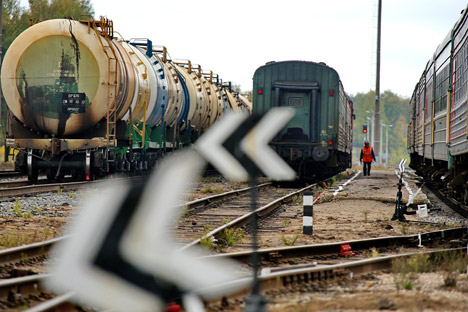
The government should support the acceleration of investment by investing in the key infrastructure projects: the high-speed highway from Moscow to Kazan, development of the Baikal-Amur Mainline and the Trans-Siberian Railway. Source: ITAR-TASS
Investments will become the main driving force of the economy in 2014–2016: Russia does not possess any other sources of acceleration in growth, says the Ministry of Economic Development in its updated macroeconomic forecast for 2014–2016.
The Ministry stipulates that a number of conditions must coincide to provide for any acceleration. First, improving the business climate and reducing external risks should lead to a reduction of capital outflow and to a resumption of capital inflow from 2016.
Then, businesses, having positively assessed growth in domestic and external demand, will increase demand for credit; the Central Bank will start to cut its interest rates, which, in turn, will accelerate growth in lending to companies from the current 14 percent to 16–17 percent in 2014. Finally, credit funds will be used to invest in import substitution and in improving the competitiveness of products.
The government should support the acceleration of investment by investing in the key infrastructure projects: the high-speed highway from Moscow to Kazan, development of the Baikal-Amur Mainline and the Trans-Siberian Railway, and the Central Ring Road project in Moscow Region.
The Ministry admits that a risk to the baseline scenario is the assumption that investment growth will increase to 3.9–6 percent (minus 1.3 percent in the period of January–August 2013, the forecast for the year is 2.5 percent). There is a greater chance that economic growth will be lower than predicted than the chance of higher growth.
However, investment can, in any case, stimulate economic growth at least over the next year, due to technical reasons.
The drop in investments this year is also mostly down to technical reasons, explains the Ministry. Gazprom, which accounts for about 10 percent of all capital investment in the Russian economy, has completed the construction of the Nord Stream pipeline, cutting its investment program by nearly one-third (see the respective article on this page).
The government has also completed a number of construction megaprojects, and government investment has decreased by 20 percent in real terms. Over the next year, there will be no such decline, and the "base effect" that had a negative impact on economic growth this year will, on the contrary, enhance growth.
This effect in the second half of 2013 is predicted to improve growth in GDP to 2.2 percent, compared to 1.4 percent in the first half.
Meanwhile, growth in private investment (excluding state-owned companies) is projected to slow down from 11 percent this year to 5 percent in 2014. Therefore, the Ministry expects a rather large contribution from quasi-budget projects — construction of roads using money from the National Welfare Fund (NWF).
Russian Railways invests $18.7 billion in Far East
Infrastructure is an opportunity to increase potential growth, and the government should therefore actively participate in this," says Oleg Zasov, director of a department in the Ministry. However, budget rules impose restrictions, and, therefore, oil and gas income is the only source of funding available.
An easing of the Central Bank's monetary policy is expected to maintain the high rates of growth in consumer lending — at least 20 percent per year, offsetting the slowdown of the growth in real incomes. As recently as a month ago, it was assumed that the latter, in 2014–2016, would be higher or at the level of 2013.
This growth will be slowed down not so much because of the decision to index tariffs for the population in 2014 (their addition to the inflation rate will only be about 0.2 percentage points), but because of the pension reform that starts in 2015.
It stipulated increased payments for pensionable service of over 30 years for women and 35 years for men, but it was decided not to implement this measure. According to the Pension Fund, more than 20 million (about a half) of today's pensioners have this pensionable service.
Downward revision of the average pension for 2015 has led to a reduced rate of growth in real incomes of about 10 percent; the predicted growth has been downgraded from 3.3 to 3 percent. The average annual nominal growth of pensions for 2014–2016 will be lower by a quarter — 7.5 percent instead of 10 percent.
An increasingly large share in the structure of consumption will be given to domestic goods, the Ministry of Economic Development predicts.
The causes of Russia's slowdown are not cyclical but rather structural, and growth in GDP is unlikely to be higher than 2 percent over the next 5–10 years, says Ivan Chakarov of Renaissance Capital. There are two options to improve this rate.
According to the expert, the state, as signals from the government appear to show, has not embraced the first option — structural reforms. Privatization has been put off and the pension reform is being delayed.
The second option — to increase the national debt — is the only option available. By Renaissance Capital calculations, growth of external debt from its current 3 percent to 35 percent of GDP (which is only half of the level of India or Brazil, says Chakarov) will attract approximately $1.2 trillion in investment to the economy.
"In the absence of reform, this is the only possible scenario for the government that would have a positive effect on the economy," said Chakarov at a Fitch conference. Money will be needed in any case, he says, with both the State Duma election and the new presidential election approaching.
First published in Russian in Vedomosti.
All rights reserved by Rossiyskaya Gazeta.
Subscribe
to our newsletter!
Get the week's best stories straight to your inbox